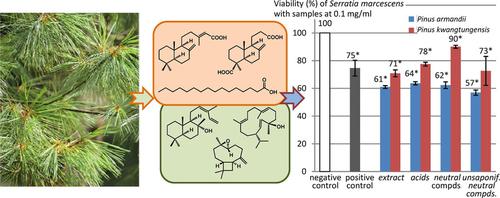当前位置:
X-MOL 学术
›
Chem. Biodivers.
›
论文详情
Our official English website, www.x-mol.net, welcomes your
feedback! (Note: you will need to create a separate account there.)
Lipophilic Metabolites from Five‐needle Pines, Pinus armandii and Pinus kwangtungensis, Exhibiting Antibacterial Activity.
Chemistry & Biodiversity ( IF 2.3 ) Pub Date : 2020-07-03 , DOI: 10.1002/cbdv.202000201 Alexander V Shpatov 1 , Tatyana S Frolova 2, 3 , Sergey A Popov 1 , Olga I Sinitsyna 2, 3 , Olga I Salnikova 1 , Guangyao Zheng 4 , Linlin Yan 4 , Nadezhda V Sinelnikova 5 , Lyudmila M Pshennikova 6 , Alexey V Kochetov 2
Chemistry & Biodiversity ( IF 2.3 ) Pub Date : 2020-07-03 , DOI: 10.1002/cbdv.202000201 Alexander V Shpatov 1 , Tatyana S Frolova 2, 3 , Sergey A Popov 1 , Olga I Sinitsyna 2, 3 , Olga I Salnikova 1 , Guangyao Zheng 4 , Linlin Yan 4 , Nadezhda V Sinelnikova 5 , Lyudmila M Pshennikova 6 , Alexey V Kochetov 2
Affiliation

|
Lipophilic extractive metabolites from needles and defoliated twigs of Pinus armandii and P. kwangtungensis were studied by GC-MS. Needles of P. armandii contained predominantly 15- O -functionalized labdane type acids (anticopalic acid), fatty acids, nonacosan-10-ol, sterols, nonacosan-10-ol and sterol saponifiable esters, and acylglycerols. While P. kwangtungensis needles comprised no anticopalic acid, but more trinorlabdane (14,15,16-trinor-8(17)-labdene-13,19-dioic acid) and other labdane type acids, nonacosan-10-ol and its saponifiable esters. The major compounds in the P. armandii defoliated twig extract were abietane and isopimarane type acids, fatty acids, sterols, labdanoids ( cis- abienol), cembranoids (isocembrol and 4- epi -isocembrol), saponifiable sterol esters, and acylglycerols. The same extract of P. kwangtungensis contained larger quantities of fatty acids, caryophyllene oxide, serratanoids, sterols, saponifiable sterol esters, and acylglycerols; but lesser amounts of abietane and isopimarane type acids, cis- abienol, and lacked cembranoids. Both twig and needle extracts of P. armandii and P. kwangtungensis , as well as the extracts' fractions, significantly inhibited the growth of Gram-negative bacteria Serratia marcescens with MIC of 0.1 mg ml -1 . While in most cases they slightly stimulated the growth of Gram-positive bacteria Bacillus subtilis at the same concentrations. Thus, lipophilic extractive compounds from needles and defoliated twigs of both pines are prospective for the development of antiseptics against Gram-negative bacteria.
中文翻译:

五针松、华山松和广东松的亲脂代谢物,具有抗菌活性。
GC-MS 研究了华山松和广东松的针叶和落叶枝条的亲脂性提取代谢物。华山假单胞菌的针主要含有 15-O-官能化的拉丹酸(anticopalic 酸)、脂肪酸、nonacosan-10-ol、甾醇、nonacosan-10-ol 和甾醇可皂化酯,以及酰基甘油。P. kwangtungensis 针叶不含抗考帕酸,但含有更多的三诺拉丹(14,15,16-trinor-8(17)-labdene-13,19-dioic acid)和其他劳丹酸,nonacosan-10-ol 及其皂化物酯类。P. armandii 落叶枝提取物中的主要化合物是松香烷和异海松烷型酸、脂肪酸、甾醇、劳丹脂类(顺式松香酚)、西松烷类(异辛醇和 4-epi-isocembrol)、可皂化甾醇酯和酰基甘油。P的相同提取物。kwangtungensis 含有大量脂肪酸、石竹烯氧化物、锯齿状核素、甾醇、可皂化甾醇酯和酰基甘油;但松香烷和异海松烷型酸、顺式松香醇的含量较少,并且缺乏西松烷类化合物。P. armandii 和 P. kwangtungensis 的枝条和针叶提取物以及提取物的级分均显着抑制了革兰氏阴性细菌粘质沙雷氏菌的生长,MIC 为 0.1 mg ml -1 。虽然在大多数情况下,它们在相同浓度下略微刺激了革兰氏阳性菌枯草芽孢杆菌的生长。因此,来自两种松树的针叶和落叶树枝的亲脂性提取物有望用于开发针对革兰氏阴性菌的防腐剂。和酰基甘油;但松香烷和异海松烷型酸、顺式松香醇的含量较少,并且缺乏西松烷类化合物。P. armandii 和 P. kwangtungensis 的枝条和针叶提取物以及提取物的级分均显着抑制了革兰氏阴性细菌粘质沙雷氏菌的生长,MIC 为 0.1 mg ml -1 。虽然在大多数情况下,它们在相同浓度下略微刺激了革兰氏阳性菌枯草芽孢杆菌的生长。因此,来自两种松树的针叶和落叶树枝的亲脂性提取物有望用于开发针对革兰氏阴性菌的防腐剂。和酰基甘油;但松香烷和异海松烷型酸、顺式松香醇的含量较少,并且缺乏西松烷类化合物。P. armandii 和 P. kwangtungensis 的枝条和针叶提取物以及提取物的级分均显着抑制了革兰氏阴性细菌粘质沙雷氏菌的生长,MIC 为 0.1 mg ml -1 。虽然在大多数情况下,它们在相同浓度下略微刺激了革兰氏阳性菌枯草芽孢杆菌的生长。因此,来自两种松树的针叶和落叶树枝的亲脂性提取物有望用于开发针对革兰氏阴性菌的防腐剂。显着抑制革兰氏阴性菌粘质沙雷氏菌的生长,MIC 为 0.1 mg ml -1 。虽然在大多数情况下,它们在相同浓度下略微刺激了革兰氏阳性菌枯草芽孢杆菌的生长。因此,来自两种松树的针叶和落叶树枝的亲脂性提取物有望用于开发针对革兰氏阴性菌的防腐剂。显着抑制革兰氏阴性菌粘质沙雷氏菌的生长,MIC 为 0.1 mg ml -1 。虽然在大多数情况下,它们在相同浓度下略微刺激了革兰氏阳性菌枯草芽孢杆菌的生长。因此,来自两种松树的针叶和落叶树枝的亲脂性提取物有望用于开发针对革兰氏阴性菌的防腐剂。
更新日期:2020-07-03
中文翻译:

五针松、华山松和广东松的亲脂代谢物,具有抗菌活性。
GC-MS 研究了华山松和广东松的针叶和落叶枝条的亲脂性提取代谢物。华山假单胞菌的针主要含有 15-O-官能化的拉丹酸(anticopalic 酸)、脂肪酸、nonacosan-10-ol、甾醇、nonacosan-10-ol 和甾醇可皂化酯,以及酰基甘油。P. kwangtungensis 针叶不含抗考帕酸,但含有更多的三诺拉丹(14,15,16-trinor-8(17)-labdene-13,19-dioic acid)和其他劳丹酸,nonacosan-10-ol 及其皂化物酯类。P. armandii 落叶枝提取物中的主要化合物是松香烷和异海松烷型酸、脂肪酸、甾醇、劳丹脂类(顺式松香酚)、西松烷类(异辛醇和 4-epi-isocembrol)、可皂化甾醇酯和酰基甘油。P的相同提取物。kwangtungensis 含有大量脂肪酸、石竹烯氧化物、锯齿状核素、甾醇、可皂化甾醇酯和酰基甘油;但松香烷和异海松烷型酸、顺式松香醇的含量较少,并且缺乏西松烷类化合物。P. armandii 和 P. kwangtungensis 的枝条和针叶提取物以及提取物的级分均显着抑制了革兰氏阴性细菌粘质沙雷氏菌的生长,MIC 为 0.1 mg ml -1 。虽然在大多数情况下,它们在相同浓度下略微刺激了革兰氏阳性菌枯草芽孢杆菌的生长。因此,来自两种松树的针叶和落叶树枝的亲脂性提取物有望用于开发针对革兰氏阴性菌的防腐剂。和酰基甘油;但松香烷和异海松烷型酸、顺式松香醇的含量较少,并且缺乏西松烷类化合物。P. armandii 和 P. kwangtungensis 的枝条和针叶提取物以及提取物的级分均显着抑制了革兰氏阴性细菌粘质沙雷氏菌的生长,MIC 为 0.1 mg ml -1 。虽然在大多数情况下,它们在相同浓度下略微刺激了革兰氏阳性菌枯草芽孢杆菌的生长。因此,来自两种松树的针叶和落叶树枝的亲脂性提取物有望用于开发针对革兰氏阴性菌的防腐剂。和酰基甘油;但松香烷和异海松烷型酸、顺式松香醇的含量较少,并且缺乏西松烷类化合物。P. armandii 和 P. kwangtungensis 的枝条和针叶提取物以及提取物的级分均显着抑制了革兰氏阴性细菌粘质沙雷氏菌的生长,MIC 为 0.1 mg ml -1 。虽然在大多数情况下,它们在相同浓度下略微刺激了革兰氏阳性菌枯草芽孢杆菌的生长。因此,来自两种松树的针叶和落叶树枝的亲脂性提取物有望用于开发针对革兰氏阴性菌的防腐剂。显着抑制革兰氏阴性菌粘质沙雷氏菌的生长,MIC 为 0.1 mg ml -1 。虽然在大多数情况下,它们在相同浓度下略微刺激了革兰氏阳性菌枯草芽孢杆菌的生长。因此,来自两种松树的针叶和落叶树枝的亲脂性提取物有望用于开发针对革兰氏阴性菌的防腐剂。显着抑制革兰氏阴性菌粘质沙雷氏菌的生长,MIC 为 0.1 mg ml -1 。虽然在大多数情况下,它们在相同浓度下略微刺激了革兰氏阳性菌枯草芽孢杆菌的生长。因此,来自两种松树的针叶和落叶树枝的亲脂性提取物有望用于开发针对革兰氏阴性菌的防腐剂。











































 京公网安备 11010802027423号
京公网安备 11010802027423号